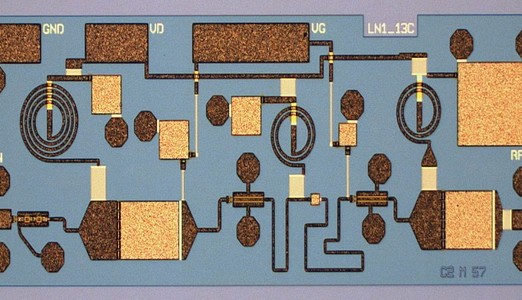Amplifier Has Noise Figure of 0.045 dB
December 10, 2013
on
on

A fundamental property for the first microwave amplifier in a radio receiver is its noise figure. This is normally given in decibel (dB). A typical noise figure for low-noise amplifiers in mobile communication systems is tenths of a decibel. Last year, Chalmers reported a world record for a low-noise amplifier that exhibited a minimum noise figure of 0.018 dB across a bandwidth of 4-8 GHz. However, since the low-noise amplifier was designed in a hybrid solution, scaling up to larger quantities turned out to be very difficult.
Chalmers has now in collaboration with a company called Low-Noise Factory published an article on an integrated ultra-low-noise amplifier. The scientists have developed a unique indium phosphide-based process for what is known as high electron mobility transistors (HEMT). Transistors and other semiconductor components have been fabricated on a monolithic chip on an indium phosphide wafer. All parts of the design such as semiconductor layers, components, process and circuit design have been optimised for the lowest noise performance. As a result, an integrated 2.0 x 0.75 mm amplifier with an ultra-low-noise figure of 0.045 dB was demonstrated. The amplifier had a very large bandwidth of 0.5-13 GHz and a high gain exceeding 38 dB across the frequency band. In order to show such extreme performance, the amplifier was cooled to minus 260 degrees of Celsius.
Chalmers has now in collaboration with a company called Low-Noise Factory published an article on an integrated ultra-low-noise amplifier. The scientists have developed a unique indium phosphide-based process for what is known as high electron mobility transistors (HEMT). Transistors and other semiconductor components have been fabricated on a monolithic chip on an indium phosphide wafer. All parts of the design such as semiconductor layers, components, process and circuit design have been optimised for the lowest noise performance. As a result, an integrated 2.0 x 0.75 mm amplifier with an ultra-low-noise figure of 0.045 dB was demonstrated. The amplifier had a very large bandwidth of 0.5-13 GHz and a high gain exceeding 38 dB across the frequency band. In order to show such extreme performance, the amplifier was cooled to minus 260 degrees of Celsius.
Read full article
Hide full article


Discussion (0 comments)